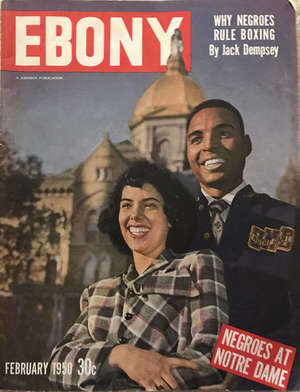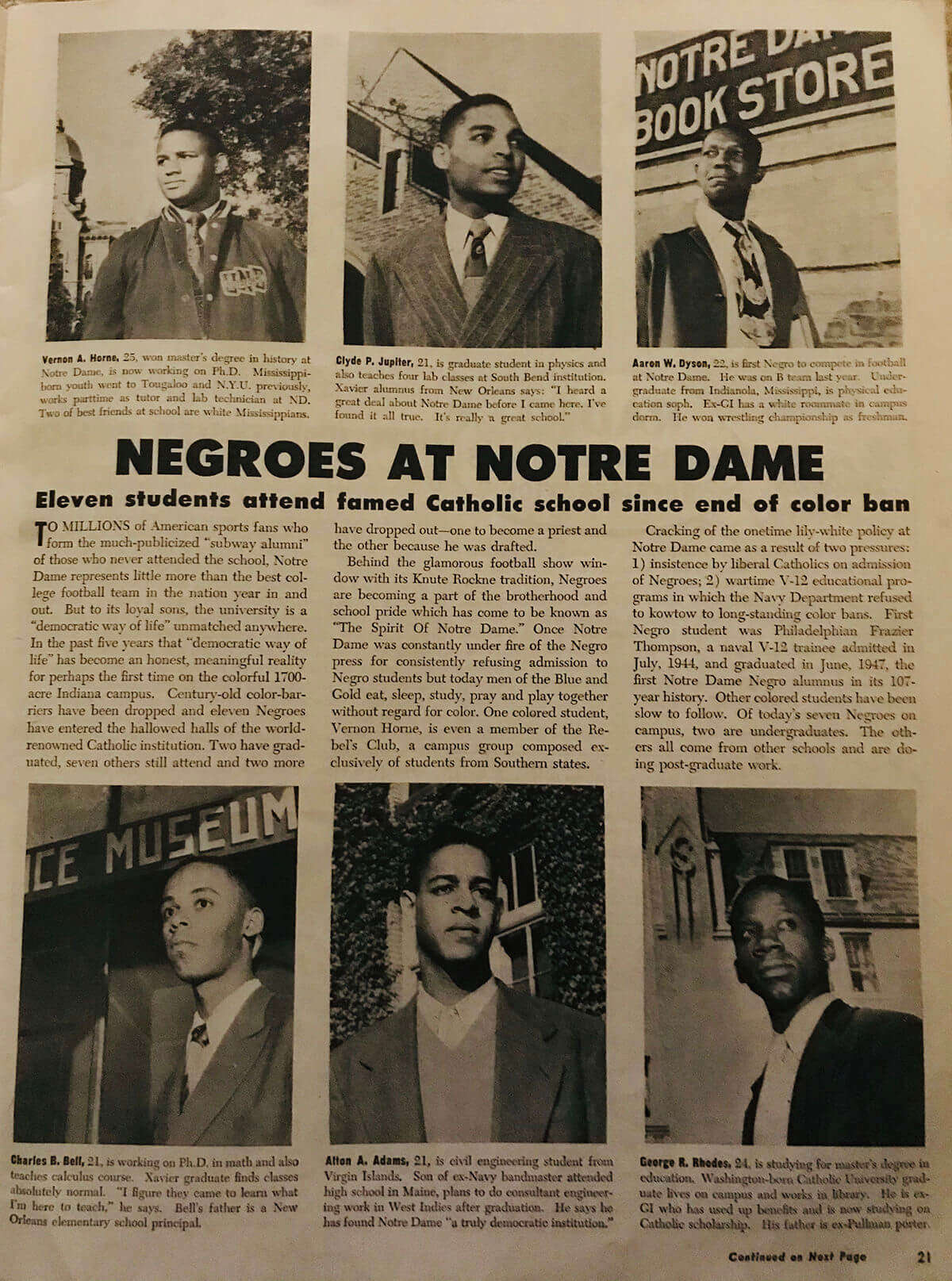A smiling African American man and woman pose on the cover, with Notre Dame’s Golden Dome visible behind them. The man wears a blue and gold jacket, adorned with an old-school “UND” logo. “Negros at Notre Dame,” the headline announces.

The February 1950 issue of Ebony magazine provides a glimpse into the University at midcentury, when African American students were recent arrivals on campus.
“Eleven [Black] students attend famed Catholic school since end of color ban,” notes the prominent magazine. Ebony had been founded in 1945 to chronicle news and culture for its target audience of Black Americans, who were seeking better jobs, higher education and equitable roles in the booming postwar economy.
I borrowed the vintage magazine from Gina Shropshire ’83 of the Mendoza College of Business while researching for a story I’m writing about a man who may have been the University’s first African American employee. Shropshire bought the issue about 15 years ago on eBay. It’s a rare and valuable find. Some issues of Ebony from that period now sell for $150 or more.
In the spring of 1950, seven African American men — two undergraduates and five graduate students — attended Notre Dame.
The magazine profiles Vernon Horne, a graduate student in history; Clyde Jupiter, a graduate student in physics; Aaron Dyson, an undergraduate whose appearance in the final home football game of the 1951 season made him the first Black player in Fighting Irish gridiron history; Charles Bell, a doctoral student in mathematics; Alton Adams, a civil engineering major; and George Rhodes, a graduate student of education.
“Cracking of the one-time lily-white policy at Notre Dame came as a result of two pressures: 1) insistence by liberal Catholics on admission of Negros; 2) wartime V-12 educational programs in which the Navy Department refused to kowtow to long-standing color bans,” Ebony reports.
The magazine also notes two African American graduates: Frazier Thompson ’47, a naval V-12 trainee, and Edward B. Williams ’47, a journalism graduate who became an African Methodist Episcopal Church minister. (Another Black graduate of that year, Carl Coggins ’47, is omitted.)

Notre Dame’s undergraduate student body was all male in those days — coeducation arrived in 1972. The pair featured on the Ebony cover are Clyde Jupiter and Coramae Richey, a black female student at the University of Chicago.
Some of the University’s first African American students, including Jupiter, later wrote about their Notre Dame experiences in essays published in the 2014 book, Black Domers.
Saint Mary’s College also had dropped its color ban and enrolled three black women students at the time. “Officials said, ‘They are well-received now and all opposition has broken down in clubs, dormitory life and, of course, our classes,’” the issue reports.
The magazine says integration was accepted more smoothly on campus than in some regions where the University recruited students, particularly in the South. Vernon Horne told the reporter that, while wearing his Notre Dame sweater, he was collared by a white police officer in his hometown of Jackson, Mississippi. The officer didn’t believe him when he said he attended Notre Dame until Horne showed him his student ID card.
For more than 75 years, Ebony, which suspended its print magazine in 2019 but still maintains a website, has chronicled daily life among black Americans. The iconic magazine’s vintage issues are a priceless cache of African American history.
The magazine’s photo archives were sold two years ago at auction for $30 million to a consortium of private foundations. The collection of nearly 4 million photos was donated to the Smithsonian’s National Museum of African American History and Culture and the Getty Research Institute, which will make them available to researchers. A new Smithsonian website explores the cultural impact of Ebony and its photography.
Margaret Fosmoe is an associate editor of this magazine.